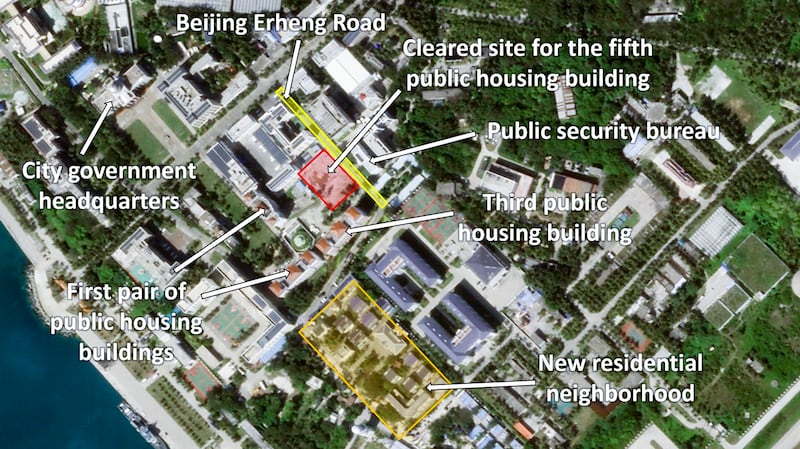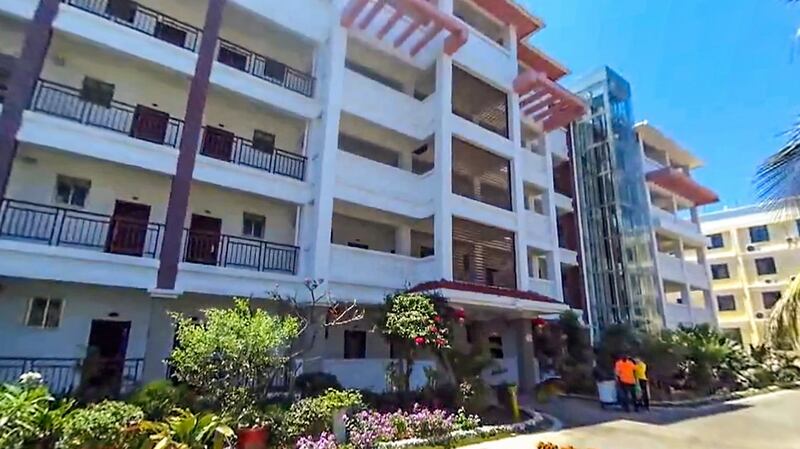China is set to construct new housing to accommodate nearly 400 people on Woody Island, a sign of its effort to support a growing population on this key outpost in the disputed South China Sea, Chinese government documents and satellite imagery show.
Bidding documents acquired by Radio Free Asia show that local officials started planning the public housing facility in mid-2020. It is the fifth such facility to be built on Woody since 2012, when China established Sansha City on the island to administer the Paracels, Spratlys, and other contested areas.
According to the records, Hainan Fangcheng Construction and Engineering Group Company Limited, a private enterprise, won the construction contract earlier this month. One of these documents reveals the planned location for the new building along Beijing Erheng Road, about 200 meters away from the city government headquarters in Sansha City.
Satellite imagery reviewed by RFA shows that an area on Beijing Erheng Road corresponding to the location described in the document was cleared in August 2020. The cleared area is between another public housing building and the city’s public security bureau, both of which are named in the bidding document.

The new housing project underscores how China is working to grow and support the populations of its remote island outposts in the South China Sea, notwithstanding the contested nature of China’s sovereignty over the features it is building on. Taiwan and Vietnam also claim the Paracel Islands.
International attention typically focuses on China’s assertive behavior at sea by its coastguard and maritime militia – which often operate out of Woody Island and China’s other outposts. Last week, China adopted legislation authorizing its coastguard to use force against foreign vessels, which was protested by the Philippine government, which described it as a “verbal threat of war.”
But China’s little-watched construction work in the Paracels and the Spratly Islands further south also sheds light on an important aspect of its ongoing strategy to assert its sweeping territorial and maritime claims.
RFA reported last week on how China has in recent months been reclaiming more land on Woody Island and reinforcing its coast against erosion, in a sign of its effort to ensure the long-term viability of its settlement there.
A bidding document for the new housing project specifies that the building will be 23 meters high, occupy 2,000 square meters, have 214 rooms, and accommodate up to 391 people. That will expand the current pool of accommodations. Two five-story public housing buildings were reportedly completed in June 2014, and the city started a second pair of public housing buildings on Woody Island in 2015. In the same year, Sansha City started constructing a new residential neighborhood on the island for fishermen.
China has worked to improve the infrastructure and living conditions on Woody Island and other settlements within the city’s jurisdiction to reduce the hardships of living there. Local officials, provincial authorities, central ministries, private and state-owned enterprises, the People’s Liberation Army (PLA), and other entities have coordinated the development of seawater desalination plants, green energy installations, storm shelters, and a wide range of other facilities.
And as this infrastructure has grown over the years, so too has Sansha City’s population.
In early 2013, Sansha’s party secretary and mayor claimed that the city had 833 permanent residents and 233 household registration-holding residents by the end of 2012. (At the time, the city's leader did not explain the differences between these two categories of residents, but "permanent residents" may refer to people who live in Sansha full-time while remaining registered elsewhere). According to official statistics from Hainan province, the city had 427 registered households with 600 residents by 2017.
As of Jan. 27 of this year, Sansha City's website reported 1,800 permanent residents, not including soldiers stationed in the city, and 621 household registration-holding residents. Other sources suggest the city had 2,500 permanent residents by 2017, again not including soldiers.
Because these figures do not include the PLA, they only capture a portion of Sansha City's population. The PLA maintains a significant presence on Woody Island and other occupied features in the Paracel and Spratly islands. For example, when Sansha City was established in 2012, a Chinese news outlet claimed that, between military and civilian personnel, China's telecommunications infrastructure in the Paracel Islands had nearly 4,000 users.
Local officials have described attracting residents to Sansha City and promoting formal household registration as a means of asserting China's sovereignty. And many of these residents — ranging from civilian bureaucrats to maritime law enforcement personnel — perform important duties related to defending China's claims in the South China Sea disputes.
The city government subsidizes the bureaucrats, workers, soldiers, and fishermen who live in the city, particularly encouraging fishermen to live in Sansha for at least 180 days per year.
Beyond building public housing projects on Woody Island, Sansha City is supporting its expanding population through other means. The city recently was recognized as a "National Sanitary City" for its public sanitation, environmental protection, and public health efforts.
The city's government has also built housing projects on other occupied features to provide a higher quality of life on once-desolate outposts. For example, in October 2019 it finished a major housing project on Tree Island in the Paracels, reportedly completing 53 houses grouped into nine larger buildings.
Bidding records from late 2020 indicate that Sansha City is planning additional housing projects on Tree Island, namely a three-story public housing building with 140 housing units, a dining hall, and other facilities.

This article has been updated to modify the byline from Zachary Haver to Zoe Haver.

